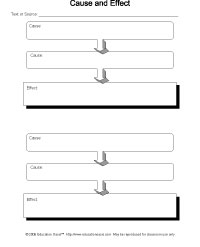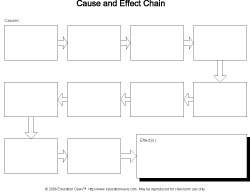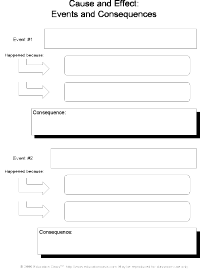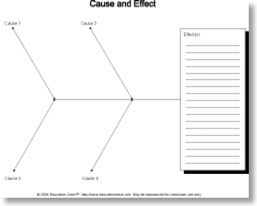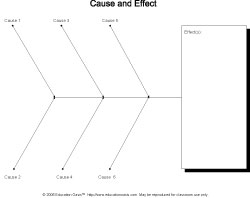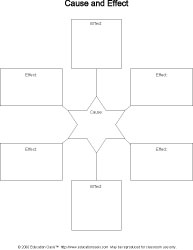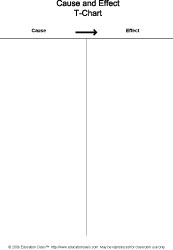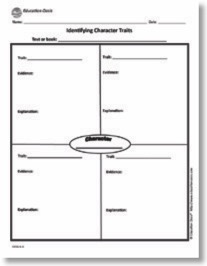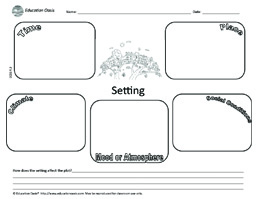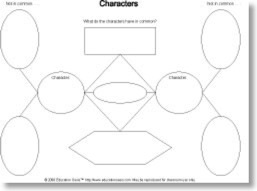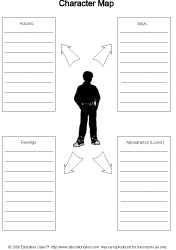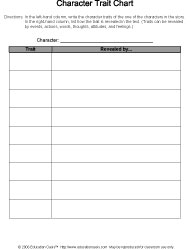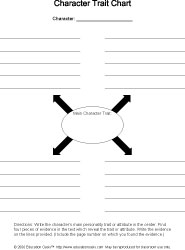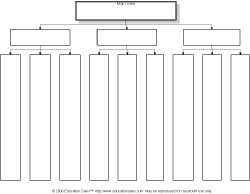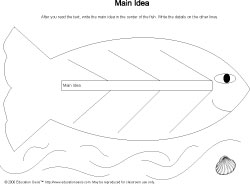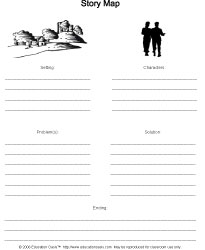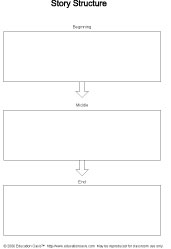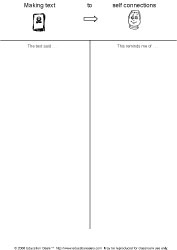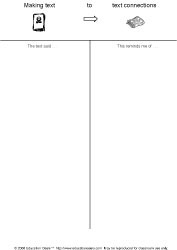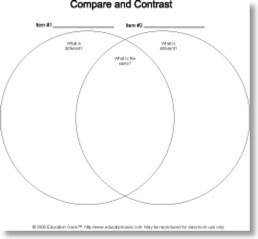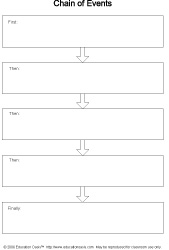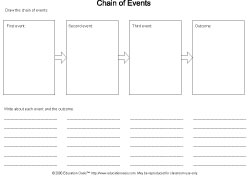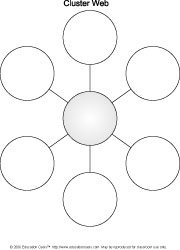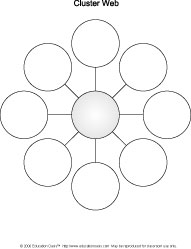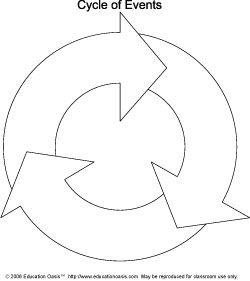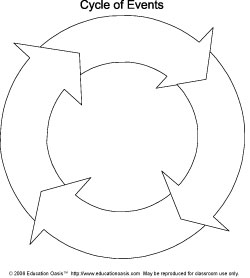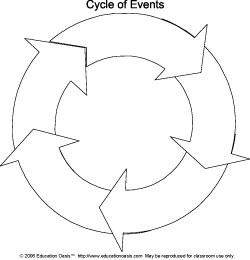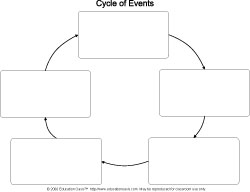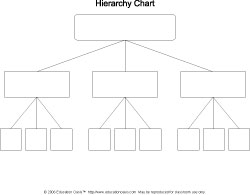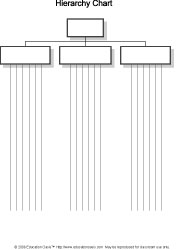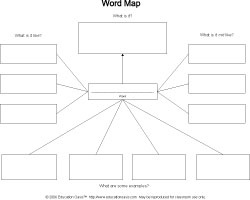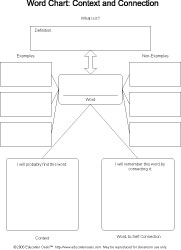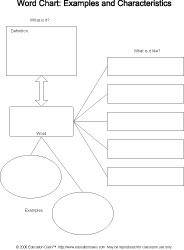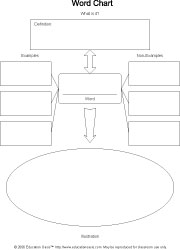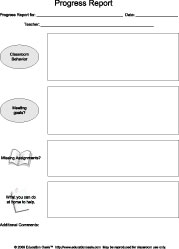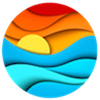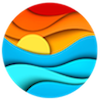
Education Oasis
Resources for Teachers by Teachers
This graphic organizer will help students identify, understand, and remember events and consequences. You may want to have students write a cause and effect paragraph after they complete the graphic organizer.
This graphic organizer will help students identify, understand, and remember multiple causes leading to an event.
This graphic organizer will help students identify, understand, and remember multiple causes and effects. This can be used as a note taking device.
This graphic organizer will help students identify, understand, and remember events, causes, and consequences. You may want to have students write a cause and effect paragraph after they complete the graphic organizer.
This graphic organizer will help students identify, understand, and remember events and consequences.
This graphic organizer will help students identify, understand, and remember events and consequences.
This graphic organizer will help students identify, understand, and remember events and consequences.
This graphic organizer will help students identify, understand, and remember multiple causes for an event.
This graphic organizer will help students identify, understand, and remember multiple effects of one cause.
This graphic organizer will help students identify, understand, and remember multiple causes and effects. It is particularly suitable for taking notes based on text or videos.
This graphic organizer will help students compare and contrast two characters in a story, novel, or film.
This graphic organizer will help students analyze a character by examining the character’s actions, thoughts, words, and appearance.
This graphic organizer will help students analyze a character by examining the character’s actions, thoughts, words, and appearance.
This graphic organizer will help students analyze a character’s main personality trait or attribute.
This graphic organizer will help students analyze a character’s main personality trait or attribute. The organizer includes a word bank of character traits.
This graphic organizer will help students analyze a character’s main personality trait or attribute. Students will find four pieces of text evidence which will reveal the trait or attribute.
Students can use this Main Idea graphic organizer to identify several main or central ideas of an expository text as well as the details that support it.
This graphic organizer is useful in allowing students to visualize the main idea of an expository text, the most important details that support it, as well as the facts which make up those details.
Students can use this Main Idea graphic organizer to identify the main or central idea of an expository text as well as the details that support it. If you wish, you can have students write the merely interesting details on the waves below the fish.
Storyboards allow students to tell a story with drawings panel by panel (like a comic strip or comic book). These can be used to plan a written or digital story. Generally there is little writing.
This graphic organizer can be used to help students identify the setting characters, problem/solution, and resolution (ending) of a story or book. Teachers may use completed graphic organizer to check for comprehension.
This graphic organizer allows students to identify and visualize all parts of a book or story. It may also be used as a comprehension check, or pre-writing, or post-writing tool.
This simple graphic organizer allows students to identify the main events of a story or book in a beginning-middle-end structure. Generally, the begging includes the setting and characters. The middle includes the problem and the events leading to a solution. The end includes the resolution and perhaps an answer to the question: “How are the characters different than they were at the beginning of the story?”
This graphic organizer allows students to record connections between the text they are reading and their own lives, beliefs, ideas, or experiences. The “text” they are using may be an excerpt, story, book, or film. The more authentic and deep the connections, the greater the students’ understanding of the original text. Additionally, making connections requires students to read more actively and thoughtfully leading to greater student engagement.
This graphic organizer allows students to record connections between the text they are reading and other texts. The “text” they are using may be an excerpt, story, book, or film. The more authentic and deep the connections, the greater the students’ understanding of the original text. Additionally, making connections requires students to read more actively and thoughtfully leading to greater student engagement.
This graphic organizer allows students to record connections between the text they are reading and the larger world. The “text” they are using may be an excerpt, story, book, or film. The more authentic and deep the connections, the greater the students’ understanding of the original text. Additionally, making connections requires students to read more actively and thoughtfully leading to greater student engagement.
This graphic organizer will allow students to generate a list of how two things are alike and different. This can be used for pre-writing. It can also be used to check for comprehension.
This graphic organizer will allow students to generate a list of how three things are alike and different. This can be used for pre-writing. It can also be used to check for comprehension.
This graphic organizer will allow students to generate a list of how two things are alike and different. This can be used for pre-writing. It can also be used to check for comprehension.
This graphic organizer will allow students to generate a list of how three things are alike and different. This can be used for pre-writing. It can also be used to check for comprehension.
This graphic organizer will allow students to generate a list of how three things are alike and different. This can be used for pre-writing. It can also be used to check for comprehension.
This graphic organizer will allow students to generate a list of how four things are alike and different. This can be used for pre-writing as well as checking for comprehension.
This graphic organizer will help students identify and remember events in a fiction or nonfiction text or video. Consider having students write a chronological description after they complete the graphic organizer.
This graphic organizer will help students identify and remember events in a fiction or nonfiction text or video. It includes transition words and is helpful for pre-writing.
This graphic organizer will help students identify and remember events. There are spaces for illustrations and writing. This may be used for pre-writing or to check student comprehension.
This graphic organizer is helpful for pre-writing and brainstorming. It can also be used for note taking with text. Have students write their topic in the center and then add details in the surrounding circles. Students may add smaller circles as necessary.
This graphic organizer is helpful for pre-writing and brainstorming. It can also be used for note taking with text. Have students write their topic in the center and then add details in the surrounding circles. Students may add smaller circles as necessary.
This graphic organizer will allow students to visualize events that occur in a cycle, such as the rock cycle. This can be used to show the sequence of events, as a pre-writing organizer, or to check for student comprehension.
This graphic organizer will allow students to visualize events that occur in a cycle. This can be used to show the sequence of events, as a pre-writing organizer, or to check for student comprehension.
This graphic organizer will allow students to visualize events that occur in a cycle. This can be used to show the sequence of events, as a pre-writing organizer, or to check for student comprehension.
This graphic organizer will allow students to visualize events that occur in a cycle. This can be used to show the sequence of events, as a pre-writing organizer, or to check for student comprehension.
This graphic organizer is useful in concept-based teaching. It allows students to see the big picture (concept at the top) as well as the topics (underneath) and then the facts (bottom) at a glance. It can also be used for classifying topics and attributes.
This graphic organizer is useful in concept-based teaching. It allows students to see the big picture (concept at the top) as well as the topics (underneath) and then the facts (bottom) at a glance. It can also be used for classifying topics and attributes.
Use this graphic organizer to activate background knowledge. Have students write down words or phrases associated with a particular topic. Consider having students work with a partner or group.
This graphic organizer allows students to explore the characteristics of a particular word by identifying what the word is, what it is like and not like, and examples.
This graphic organizer allows students to explore important information about a particular word or concept by identifying the definition, characteristics, examples, and non-examples.
This graphic organizer allows students to explore important information about a particular word by identifying the definition, examples, and non-examples. In addition, the student is encouraged to think about the context in which he or she would find the word as well as make a personal connection to the word.
This graphic organizer allows students to explore important information about a particular word by identifying the definition, examples, and non-examples.
This graphic organizer allows students to explore important information about a particular word by identifying the definition, examples, and non-examples. Students then illustrate the word.
This graphic organizer is useful in helping students consider, record, and track their goals and progress toward those goals. By breaking down a goal into steps, students can visualize and better understand the process.
This KWL chart is a classic reading strategy used by teachers since the mid 1980s. Students activate their background knowledge or schema as they brainstorm what they know about a topic under the “K” column. They then set a purpose for reading by noting what they want to know under the “W” column. Finally, they record what they learned under the “L” column.
This is an individual student Progress Report. You may want to pair this with the Goal Setting Worksheet.
This graphic organizer can help both students and teachers generate questions that range from factual to higher-level synthesis and application questions. The farther down and to the right you go, the more complex the question.
This graphic organizer allows students to record their individual responses to questions or prompts. After discussion with a partner, students can note what their partner thought. Together they can then decide what they will share with the group. It is particularly useful for brainstorming, content review, and generating responses to critical-thinking questions. Think-Pair-Shares allow students “think time” to process their own thoughts before sharing with a partner or group.




